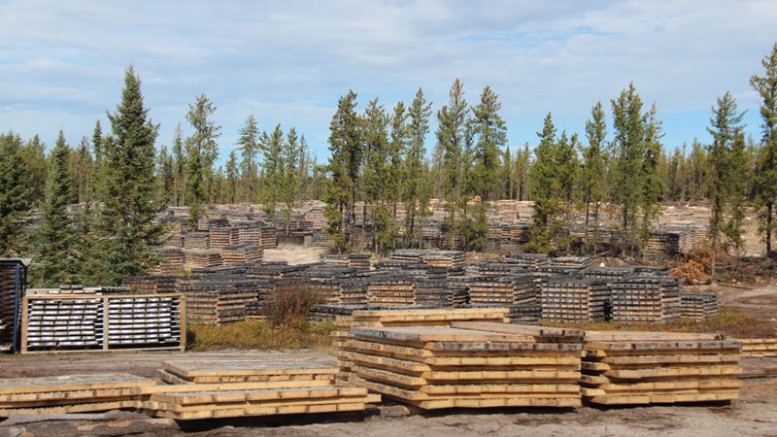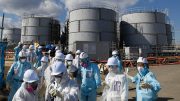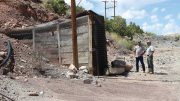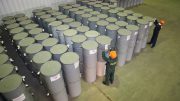VANCOUVER — Lukas Lundin’s Denison Mines (TSX: DML; NYSE-MKT: DNN) has one vision at its Wheeler River joint venture in Saskatchewan’s Athabasca basin: to become Canada’s next uranium producer. The company may not be making headlines with grassroots discoveries of late, but it is steadily advancing its Phoenix and Gryphon uranium deposits toward a 2025 production target, while attempting to control equity dilution.
The project sits in the infrastructure-rich eastern part of the Athabasca basin, and is a joint venture between Denison (66% ownership and operator by 2018), Cameco (TSX: CCO; NYSE: CCJ) (30% ownership) and JCU Exploration (10% ownership).
Denison wasn’t always focused on Wheeler River. President and CEO David Cates attributes the shifting priorities to recent doldrums in uranium markets that are taking a toll across the entire industry.
“There has been a tighter strategy in terms of exploration. We previously worked on 10 to 15 projects at any given time, but that was obviously a different commodity market,” Cates says during an interview at Denison’s Vancouver offices.

Visitors view core samples at Denison Mines’ Wheeler River uranium project in Saskatchewan. Credit: Denison Mines.
“We were looking to generate a pipeline of targets because we had a large portfolio, but now we’re at historic lows in uranium. We need to reduce capital spending. You have to watch your equity dilution right now, so we’ve become much more focused on Wheeler River. We’re much more of a production story, and that strategy differentiates us from our peer group,” he continues.
Denison’s strategy is based on a supply-demand scenario that stretches over the next five to 10 years. The company acknowledges that Athabasca basin deposits tend to have longer development lead times relative to projects in Africa or the U.S. due to regulatory processes and logistical considerations.
Denison has a good read on uranium fundamentals because of two relationships it has in the market. First, the company manages Uranium Participation (TSX: U; US-OTC: URPTF), which invests 85% of its equity offering proceeds into uranium oxide in concentrates (U3O8) and uranium hexafluoride. Second, it holds a 22.5% interest in the McClean Lake joint venture, which includes several uranium deposits and the McClean Lake uranium mill.
“What we’ll watch over the next few years are utilities and uncovered demands. Today everything is covered to generate nuclear energy, but in 10 years, 75% of the uranium utilities required hasn’t been purchased yet,” Cates says.
“We’re looking at this and thinking everyone needs to be buying for 2025. There is a risk level before that, however, where 30% of the uranium requirements will be uncovered, and it’s not very far away. There’s an emerging need for utilities to contract again, and it’s going to get interesting in our space,” he says.

Areva, Denison Mines and OURD Co.’s McClean Lake uranium mill in northern Saskatchewan. Credit: Denison Mines.
To benefit from potential market improvements, Denison aims to release a prefeasibility study (PFS) on Wheeler River by 2018 that will set the stage for project financing and permitting.
The strategy underpins 80,000 metres of drilling the company will complete on Phoenix and Gryphon by the end of 2017, which is heavily focused on generating indicated resources and optimizing the mine plan.
Denison is building on a preliminary economic assessment it released on the project in April 2016.
The existing model involves basement-hosted resources at Gryphon totalling 834,000 inferred tonnes at 2.3% U3O8 for 43 million contained lb., and 166,000 indicated tonnes at Phoenix grading 19.1% U3O8 for 70.2 million contained pounds.

Drills in 2015 at Denison Mines’ Wheeler River uranium project in northern Saskatchewan’s Athabasca basin. Credit: Denison Mines.
Gryphon would produce 40.7 million lb. U3O8, over a seven-year mine life, at a cash-operating cost of US$14.28 per pound. Phoenix would then generate 64 million lb. U3O8, over a nine-year mine life, at a cash-operating cost of US$22.15 per pound.
The development requires $560 million in total preproduction capital and features a pre-tax net present value (NPV) of $513 million at an 8% discount rate and a 20.4% internal rate of return. Economic results are based on a long-term uranium price of US$44 per pound.

Chad Sorba (left) and Denis Goulet at Denison Mines’ Wheeler River project. Credit: Denison Mines.
“We really want to achieve the maximum amount of indicated resources at Gryphon heading into the PFS,” Cates adds. “That can really help our economics because the material at that deposit tends to be lower cost in terms of production. In addition, the sustained capital to develop Phoenix also gets pushed out a certain number of years and discounted more. The core prize is a project we can finance and move ahead with permitting. That’s really where our exploration program is focused this year.”
Denison recently unveiled a $14.5-million, joint-exploration budget that expands mineralization around Gryphon with 46,000 metres of exploration and infill drilling.
The company sees potential resource upside at newfound D-series lenses north of Gryphon, where 2016 assay highlights include: 11 metres of 5.3% U3O8 from 718 metres deep in hole 641; and 6 metres averaging 2.9% U3O8 from 759 metres deep in hole 633D1. Denison drilled 40,000 metres on the D-series targets last year.

Project geologist Yongxing Liu at a core-storage facility at Denison Mines’ Wheeler River uranium project in Saskatchewan. Credit: Denison Mines.
Furthermore, Denison recently discovered “additional high-grade mineralization” downdip and up-dip of Gryphon’s A and B series lenses that lies outside resource calculations. For example, drill hole 674 cut 4.4 metres of 2.5% eU3O8 from 744 metres downdip of the A and B series; while hole 602D1 intersected 11.4 metres of 1.2% eU3O8 from 693 metres deep.
“We hit mineralization in the footwall outside the Gryphon zone, and the D series became a major focus for us as we stepped out along strike,” Denison’s vice-president of exploration Dale Verran says.
“It’s going to have significant impact on our resources moving forward. The key thing to note is that the D lenses are still open, and we see potential northwest and southeast. Then, in the summer, we came in and tested downdip of the A and B lenses and cut good grades at nice thicknesses. In fact, it was an improvement from the holes that were drilled updip,” he continues.
Though Denison remains committed to achieving production, it hasn’t entirely moved away from acquisitions and greenfield exploration. In late 2016 the company moved into the western Athabasca basin via the acquisition of an 80% interest in the Hook-Carter property, which is on strike from NexGen Energy’s (TSX: NXE; US-OTC: NXGEF) emerging Arrow discovery and Fission Uranium’s (TSX: FCU; US-OTC: FCUUF) Triple R deposit beside and under Patterson Lake.
Denison acquired Hook-Carter from ALX Uranium (TSXV: AL; US-OTC: ALXEF) in exchange for 7.5 million shares and $12 million in exploration expenses. The company consolidated the project by buying the Coppin Lake property, which lies between the Carter East and Carter West blocks.
“We will continue to look at projects outside of Wheeler, but focus on potential high-impact discovery targets,” Cates says. “Hook-Carter is one opportunity we’re excited about along the Patterson Lake corridor. We have unconformity and basement potential to test, and there have only been five holes drilled to date along our trend. The real strategy for us is becoming the next uranium producer, and a core part of that is adding long-term discovery assets to the portfolio.”
Denison shares have traded in a 52-week range of 49¢ to $1.08 per share, and gained 34% over the first four weeks of 2017 to close at 98¢ at press time.
The company had 533.4 million shares outstanding for a $518.3-million market capitalization at press time, and reported US$11.8 million in cash and equivalents in September.






Smart smart management doing the right things given the market or lack there of. Shares are in the bargain basement and if they continue to stave off dilution holders will do well.